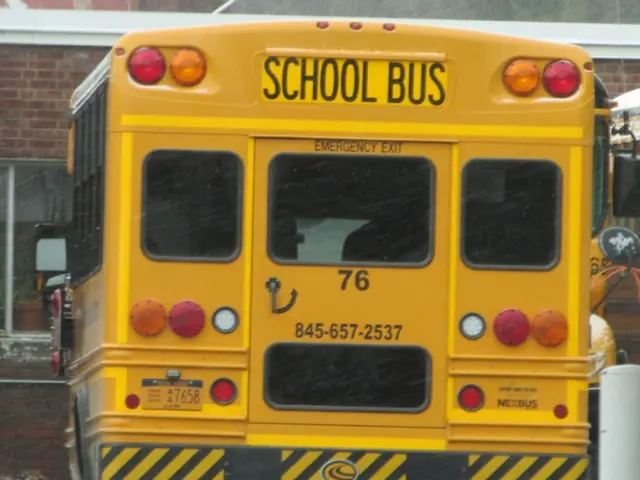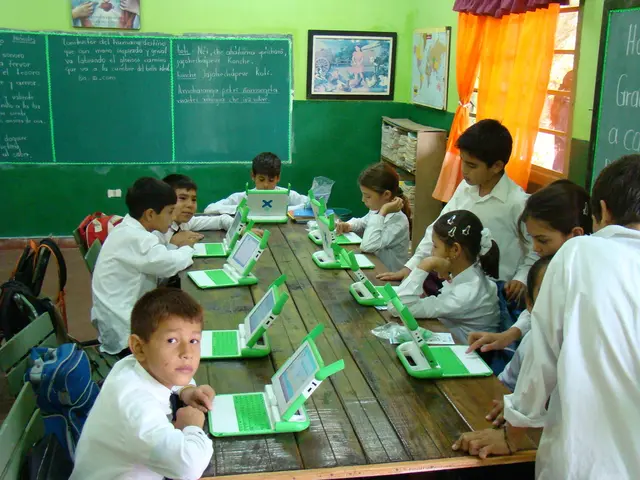Teaching Sessions Offer a Valuable Training Experience and Provide a Pre-existing Pathway for Emerging Educators
In an era where teacher shortages are a persistent crisis in many school districts, innovative approaches are being adopted to attract and train the next generation of educators. One such strategy is the utilization of tutoring programs as a strategic talent pipeline.
Take the case of Stephanie Martinez-Calderon, a middle school teacher in the Washoe County School District in Nevada. Her journey into teaching began as a tutor, providing remote support after graduating from Knox College in Illinois. Tutoring helped Stephanie build confidence and develop her instructional skills, paving the way for her successful career as a teacher.
The effectiveness of tutoring programs in attracting aspiring educators is evident in initiatives like the Teach for America's Ignite Fellowship. Launched in 2020, this programme has led to 400 of its former tutors becoming full-time teachers. The Ignite Fellowship has proven to be especially effective at drawing in candidates who may not have initially envisioned themselves in the classroom.
Similarly, the Washington, D.C. school district launched a tutor-to-teacher apprenticeship program after success with high-impact tutoring. This programme provided a supportive, lower-stakes environment for aspiring educators to build their core teaching skills, preparing them for the challenges of the classroom.
The appeal of teaching as a profession for Gen Z professionals is heightened by the offering of flexible, purpose-driven opportunities. Research shows that Gen Z tutors value flexibility, remote opportunities, mental health, stability, and mission-driven work.
Some school districts are leveraging this trend to their advantage. In Texas, teacher residents are required to work as tutors and in other support roles while co-teaching with a mentor. This approach not only provides real classroom experience but also supports participants in passing certification exams like the Praxis.
School districts can also redirect Title I funds, use federal work-study, and create apprenticeship programs to fund tutoring programs and pay tutors. Collaborations with local universities offer dual enrollment, early credentialing, and work-based learning to create direct pathways from tutoring or paraprofessional roles into full teaching credentials.
Innovative recruitment strategies are also being employed. Districts are utilising social media, videos, and storytelling to highlight the value and purpose of teaching careers, making the profession appealing to young people reconsidering their career options post-pandemic. Showcasing success stories of former tutors turned teachers is a particularly effective approach.
Combining tutoring with coaching and mentoring is another key strategy. Programmes integrate teacher coaching to prepare tutor-candidates for the demands of certified teaching roles, promoting quality alongside quantity in recruitment.
Recognising that finding teachers is only part of addressing shortages, some districts are allocating significant funds not only to hire more teachers but also to improve recruitment and retention efforts. Non-digital and digital recruitment channels are being used, with districts utilising traditional outreach like flyers and community engagement alongside online platforms.
In conclusion, tutoring programs serve as an effective entry point for Generation Z and others to enter teaching by providing immersive, supported experiences leading to certification. When combined with strategic partnerships, tailored coaching, and innovative recruitment branding, these programs help districts build a sustainable educator pipeline that addresses ongoing shortages while improving teacher quality and retention. Tutoring programs can, thus, serve as strategic talent pipelines that strengthen the future of the teaching workforce.
[1] Allen, M. (2021, March 16). How to Build the Next Generation of Teachers. Education Week. Retrieved from https://www.edweek.org/leadership/opinion-how-to-build-the-next-generation-of-teachers/2021/03 [2] Grossman, P., & Loeb, S. (2015, August 11). The Long-Run Impacts of Teacher Residencies on Teacher Quality and Student Achievement. National Bureau of Economic Research. Retrieved from https://www.nber.org/papers/w21567 [3] Kahlenberg, R. (2020, December 15). How to Recruit and Train More Teachers. Brookings Institution. Retrieved from https://www.brookings.edu/research/how-to-recruit-and-train-more-teachers/ [4] Saga Education. (n.d.). Our Approach. Retrieved from https://sagaeducation.org/our-approach/ [5] Wang, J. (2020, April 15). How to Build a Sustainable Teaching Workforce in a Post-Pandemic World. Education Week. Retrieved from https://www.edweek.org/leadership/opinion-how-to-build-a-sustainable-teaching-workforce-in-a-post-pandemic-world/2020/04
- The utilization of tutoring programs as a strategic talent pipeline resonates strongly with Gen Z tutors, who value flexibility, remote opportunities, mental health, stability, and mission-driven work, thereby addressing the appeal of teaching as a profession for this demographic.
- The implementation of tutoring programs, coupled with strategic partnerships, tailored coaching, and innovative recruitment branding, can facilitate the building of a sustainable educator pipeline, providing immersive, supported experiences leading to certification, and thus serving as strategic talent pipelines that strengthen the future of the teaching workforce, addressing teacher shortages and improving teacher quality and retention.




